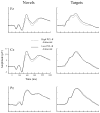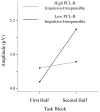Reconciling discrepant findings for P3 brain response in criminal psychopathy through reference to the concept of externalizing proneness
- PMID: 24579849
- PMCID: PMC3984346
- DOI: 10.1111/psyp.12189
Reconciling discrepant findings for P3 brain response in criminal psychopathy through reference to the concept of externalizing proneness
Abstract
We sought to address inconsistencies in the literature on amplitude of P3 brain potential response in offenders diagnosed with psychopathy. These inconsistencies contrast with the reliable finding of reduced P3 in relation to externalizing tendencies, which overlap with impulsive-antisocial features of psychopathy, as distinguished from the affective-interpersonal features. Employing a sample of incarcerated male offenders (N = 154) who completed the Psychopathy Checklist-Revised along with a three-stimulus visual oddball task, we tested the hypothesis that impulsive-antisocial features of psychopathy would selectively exhibit an inverse relationship with P3 amplitude. Clear support for this hypothesis was obtained. Our findings clarify the discrepant findings regarding psychopathy and P3, and establish P3 as a neurophysiological point of contact between psychopathy and externalizing proneness from the broader psychopathology literature.
Keywords: Antisocial behavior; EEG/ERP; Externalizing; P3; Psychopathy.
Copyright © 2014 Society for Psychophysiological Research.
Figures


Similar articles
-
Antisocial behaviour and psychopathy: Uncovering the externalizing link in the P3 modulation.Neurosci Biobehav Rev. 2018 Aug;91:170-186. doi: 10.1016/j.neubiorev.2017.03.012. Epub 2017 Mar 22. Neurosci Biobehav Rev. 2018. PMID: 28342766
-
Factors of psychopathy and electrocortical response to emotional pictures: Further evidence for a two-process theory.J Abnorm Psychol. 2015 May;124(2):319-28. doi: 10.1037/abn0000032. Epub 2015 Jan 19. J Abnorm Psychol. 2015. PMID: 25603361 Free PMC article.
-
Reduced cortical call to arms differentiates psychopathy from antisocial personality disorder.Psychol Med. 2013 Apr;43(4):825-35. doi: 10.1017/S0033291712001547. Epub 2012 Jul 31. Psychol Med. 2013. PMID: 22850322
-
Differentiating psychopathy from general antisociality using the P3 as a psychophysiological correlate of attentional allocation.PLoS One. 2012;7(11):e50339. doi: 10.1371/journal.pone.0050339. Epub 2012 Nov 16. PLoS One. 2012. PMID: 23166843 Free PMC article.
-
Psychopathy: theory, measurement, and treatment.Trauma Violence Abuse. 2006 Jul;7(3):155-74. doi: 10.1177/1524838006288929. Trauma Violence Abuse. 2006. PMID: 16785285 Review.
Cited by
-
P300 Event-Related Potentials Mediate the Relationship Between Child Physical Abuse and Externalizing Behavior.Front Psychol. 2021 Nov 1;12:720094. doi: 10.3389/fpsyg.2021.720094. eCollection 2021. Front Psychol. 2021. PMID: 34790145 Free PMC article.
-
Psychopathic traits associated with abnormal hemodynamic activity in salience and default mode networks during auditory oddball task.Cogn Affect Behav Neurosci. 2018 Jun;18(3):564-580. doi: 10.3758/s13415-018-0588-2. Cogn Affect Behav Neurosci. 2018. PMID: 29633199 Free PMC article.
-
Effects of Transcutaneous Vagus Nerve Stimulation (tVNS) on the P300 and Alpha-Amylase Level: A Pilot Study.Front Hum Neurosci. 2018 Jun 21;12:202. doi: 10.3389/fnhum.2018.00202. eCollection 2018. Front Hum Neurosci. 2018. PMID: 29977196 Free PMC article.
-
Externalizing proneness and brain response during pre-cuing and viewing of emotional pictures.Soc Cogn Affect Neurosci. 2016 Jul;11(7):1102-10. doi: 10.1093/scan/nsv080. Epub 2015 Jun 24. Soc Cogn Affect Neurosci. 2016. PMID: 26113614 Free PMC article.
-
One-year developmental stability and covariance among oddball, novelty, go/no-go, and flanker event-related potentials in adolescence: A monozygotic twin study.Psychophysiology. 2016 Jul;53(7):991-1007. doi: 10.1111/psyp.12646. Epub 2016 Mar 21. Psychophysiology. 2016. PMID: 26997525 Free PMC article.
References
-
- Blair RJR. Applying a cognitive neuroscience perspective to the disorder of psychopathy. Development and Psychopathology. 2005;17:865–891. - PubMed
-
- Begleiter H, Porjesz B, Bihari B, Kissin B. Event-related potentials in boys at risk for alcoholism. Science. 1984;225:1493–1496. - PubMed
-
- Blackwood DH, Whalley LJ, Christie JE, Blackburn IM, St Clair DM, McInnes A. Changes in auditory P3 event-related potential in schizophrenia and depression. British Journal of Psychiatry. 1987;150:154–160. - PubMed
Publication types
MeSH terms
Grants and funding
LinkOut - more resources
Full Text Sources
Other Literature Sources

